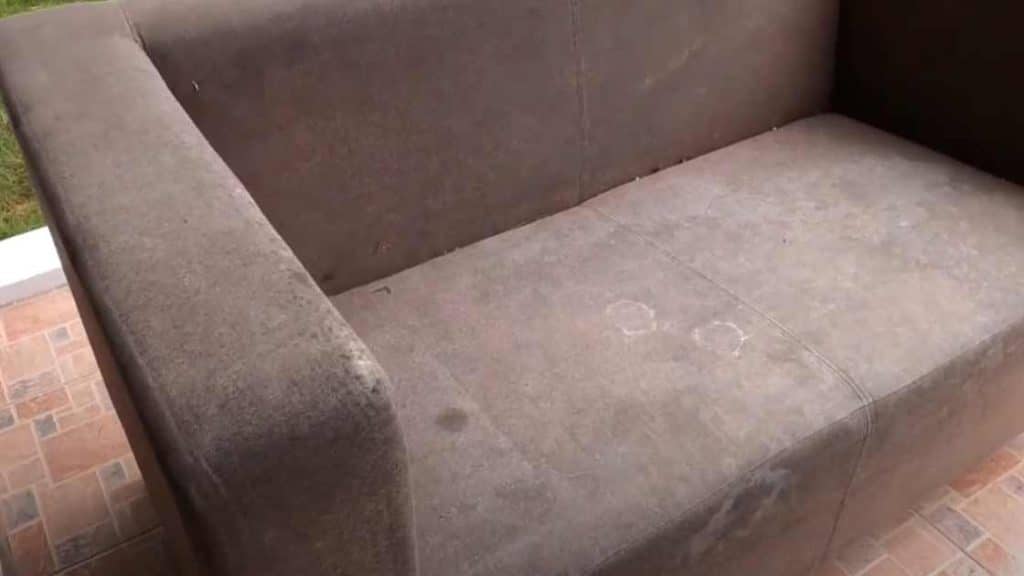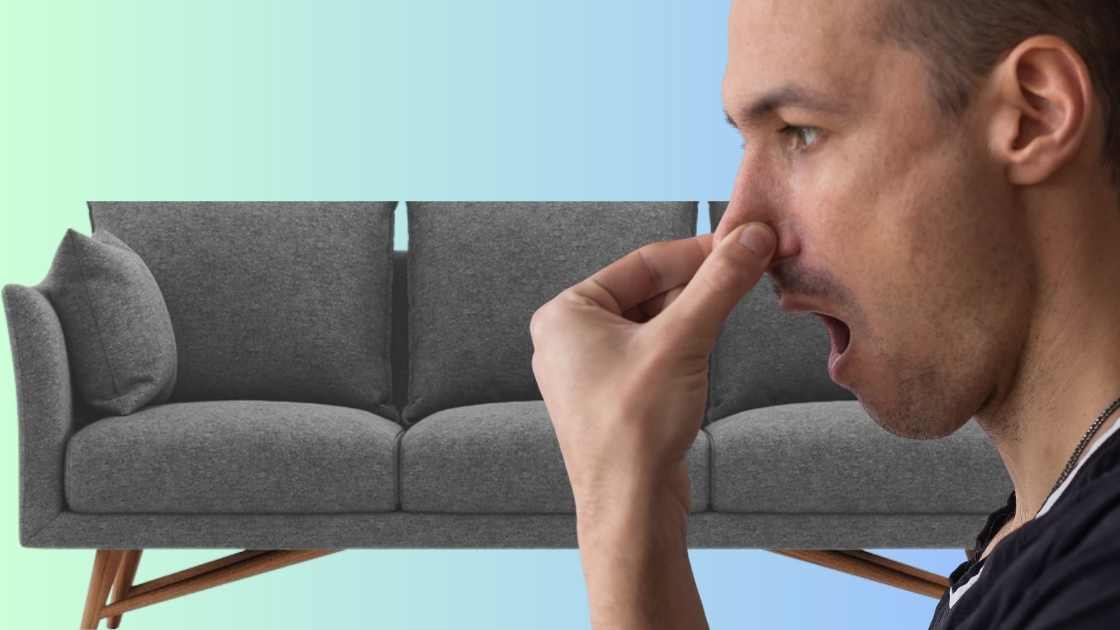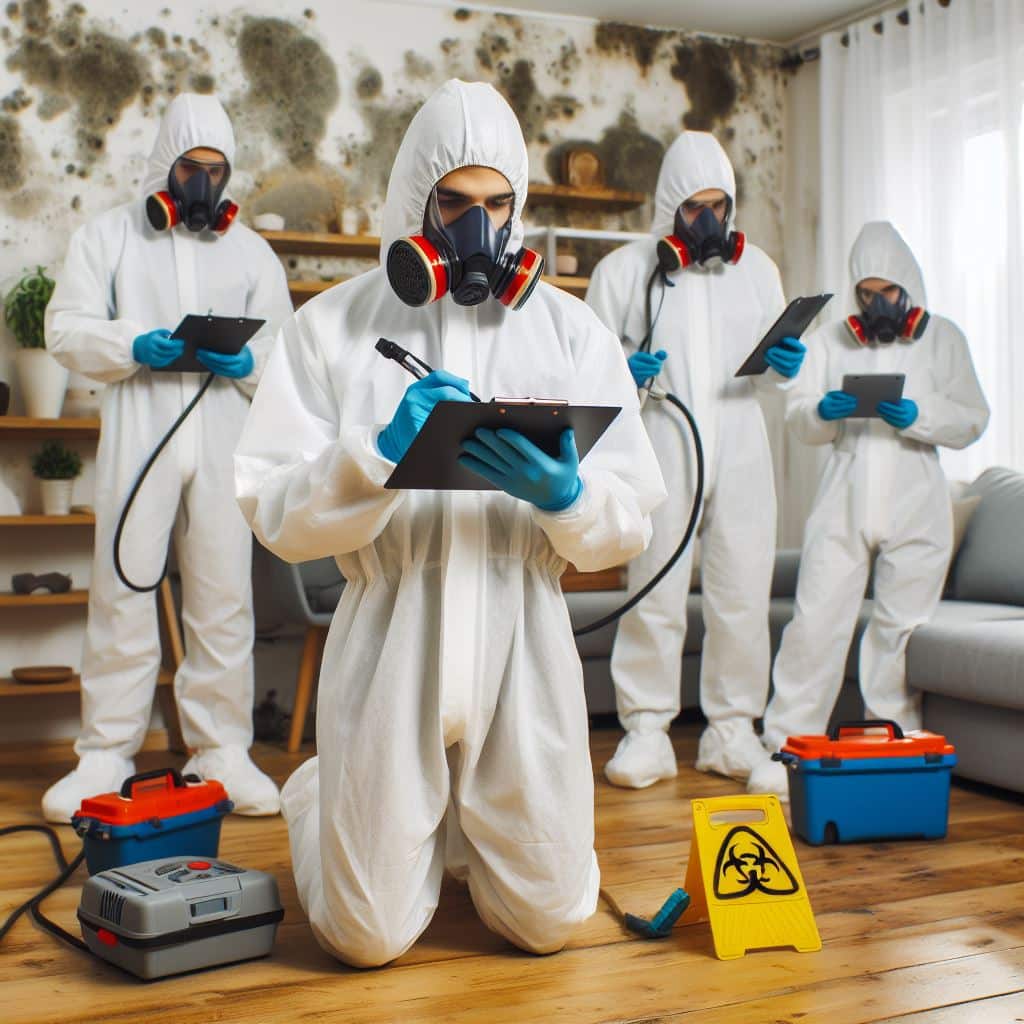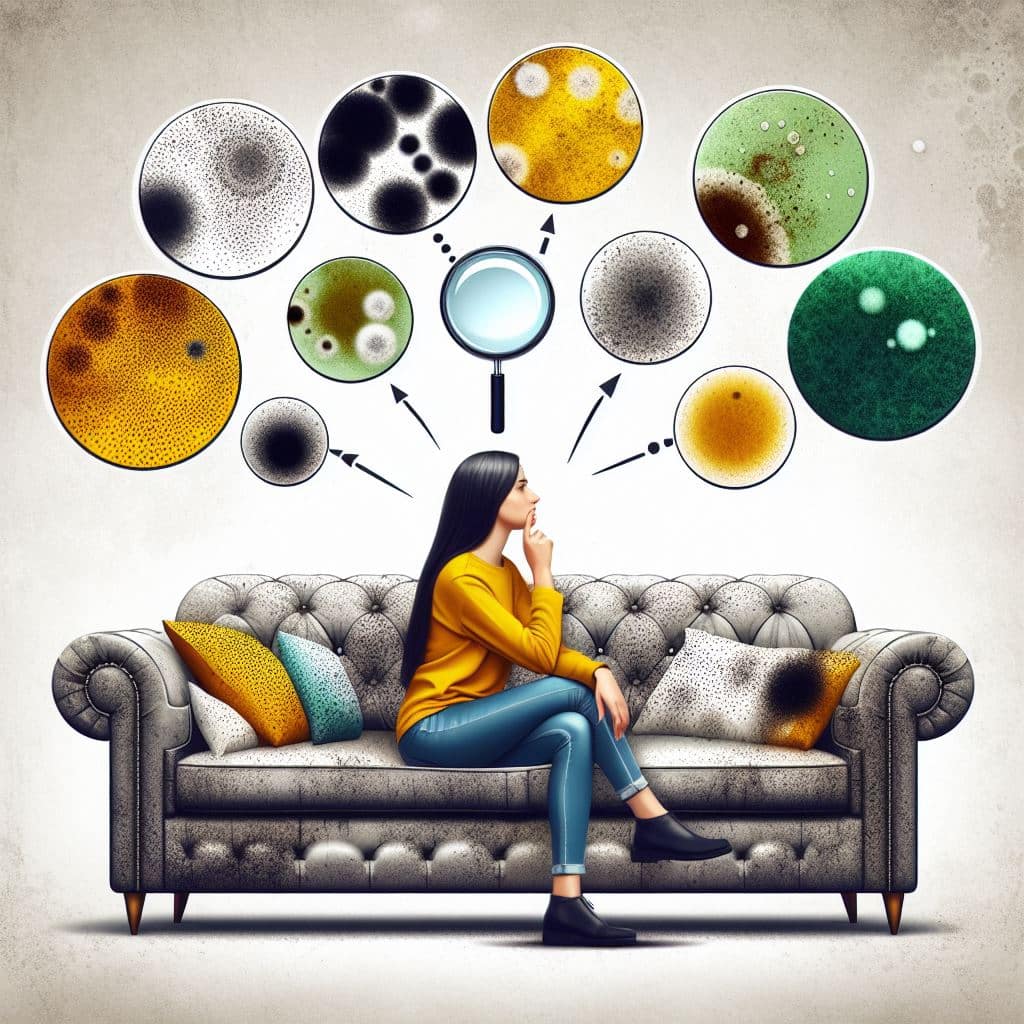Mold on a couch typically manifests as discolored patches or spots. These can range from white and greenish to black and brown.
Have you ever wondered, “What does mold on a couch look like?” Discovering mold on your couch can be both unsightly and unhealthy. Given the right conditions, such as warmth, moisture, and organic material, mold spores can thrive on your furniture.
This fungal menace may start as specks but can quickly spread over the fabric, feasting on the material and the organic debris it absorbs from the environment.

The presence of mold not only damages the aesthetic appeal of your couch but also poses a risk to your indoor air quality and health.
Spotting mold early on a couch is key to preventing its spread and ensuring the longevity of your furniture and the well-being of your home environment.
Acting promptly upon the first sign of mold keeps your living space clean, hygienic, and inviting.
Meet Mold at Home
Imagine sitting on your cozy couch and spotting something unusual. It’s not just a stain, it’s mold. Molds are tiny, sneaky, and can grow almost anywhere in homes.
Often, they go unnoticed until they form large colonies, presenting as spots of varying colors ranging from black, green, or white fuzzy textures on surfaces.
Mold Growth In Homes

Mold loves damp, warm, and humid environments. A wet couch, due to spills or humidity, may invite mold. Molds spread by releasing spores into the air. These spores need moisture and organic material to grow, and furniture fabrics provide just that.
- Leaky windows
- Spills not dried properly
- High indoor humidity
These conditions can make homes ideal for mold.
Health Implications Of Mold Exposure
Mold exposure can lead to health problems. Individuals with allergies or asthma may experience symptoms like coughing or difficulty breathing.
Long-term exposure can affect even those without pre-existing conditions. Children and the elderly are especially vulnerable.
| Who | Risks |
|---|---|
| People with allergies | Increase in symptoms |
| People with asthma | Worsening of condition |
| Children & Elderly | Higher susceptibility |
Keeping homes mold-free is not just about cleanliness, but health too.
Common Types Of Mold Found On Furniture
Finding mold on your furniture can be a nasty surprise. Common types of mold on furniture range from mildew to black mold. This guide helps you identify what may be growing on your couch.
Identifying Different Mold Species
- Aspergillus: Common indoors, it appears powdery with shades of yellow, green, or black.
- Penicillium: Known for its blue-green color, it often has a musty odor.
- Cladosporium: This type could look olive-green to brown and thrive on fabrics.
- Alternaria: It forms dark velvet-like spots and often feels dry.
- Stachybotrys: Known as black mold, it’s slimy and features dark rings.
Characteristics Of Molds On Various Materials
| Material | Appearance | Texture |
|---|---|---|
| Leather | Splotches with fuzzy or slimy texture | Usually sticky to the touch |
| Fabric | Stains with many colors | Often powdery or cottony |
| Wood | Discolorations, often black or green | Can be slimy or dry and cracked |
Identifying mold types on furniture is crucial to handling it correctly. Use the information above to take the first step and keep your furniture safe.
Visual Indicators Of Mold On Couches

Finding mold on a couch can be unsettling. It’s essential to identify it quickly to maintain a healthy home environment. Recognizing mold involves inspecting different visual clues. Let’s examine the common signs you might notice on your furniture.
Mold comes in a rich palette of colors and textures. Here is a quick guide to mold hues and surface appearances:
- Black or green patches often signal mold presence.
- White, thread-like mold shows early growth stages.
- Velvety textures can indicate certain mold types.
- Gray-brown, gray-green, or pink spots suggest varied mold species.
Different molds show diverse textures, from slimy to fuzzy. Early intervention can safeguard your couch and health.
Spotting Mold: Early Signs To Look For
Staying alert for early mold detection is essential. Below are signs to watch for:
| Sign | Description |
|---|---|
| Musty Smell | A distinct odor often accompanies mold growth. |
| Dampness | Mold thrives in moist areas. Feel for wet spots. |
| Discoloration | Unexplained stains can be a mold indicator. |
| Allergic Reactions | Sneezing or itching when near the couch may hint at mold. |
Stay vigilant for these signs to catch mold before it spreads. Quick action keeps your couch safe for use.
Smell: A Key Identifier Of Mold Presence
Spotting mold on a couch might not always be straightforward. A strange smell can be the first sign. This odor helps to detect hidden mold. It is distinct and often the first clue of mold growth.
Describing The Odor Of Mold On Fabric

Imagine entering a room with a damp, musty scent. That’s what mold on couch fabric often smells like. It’s a tell-tale sign that spores have begun to live and multiply in the material.
- Musty: A word that often comes up when describing mold odor. It is like old books or wet socks.
- Earth-like: Some describe mold as smelling like soil or compost.
- Stale: An indication that air circulation is poor, which helps mold thrive.
The Relationship Between Mold Smell And Severity Of Infestation
The intensity of mold smell often relates to the mold growth’s severity. A stronger smell can indicate a larger or more entrenched infestation.
| Smell Strength | Infestation Severity |
|---|---|
| Moderate | Early stages, possibly treatable with DIY solutions. |
| Strong | Advanced infestation, likely requires professional intervention. |
| Overwhelming | Extensive growth, health risks, and immediate action are needed. |
Keep an eye out for persistent, unusual scents when evaluating your couch. Addressing the mold quickly reduces the risk of it spreading throughout the home.
The Hazards Of Ignoring Mold On Couches

Tackling the sneaky culprit of home comfort, mold on a couch isn’t just an eyesore; it carries risks. Let’s sink into the hazards of turning a blind eye to this fuzzy intruder.
Long-term Damage To Furniture
Mold silently breaks down the integrity of a couch. Over time, this can lead to irreparable damage. Cushions become spongy, fabric discolors, and wooden frames may rot. Addressing mold early saves favorite lounging spots from heading to the landfill.
- Aesthetic Downfall: Mold spots create unsightly patches.
- Fabric Ruin: Deterioration of materials becomes inevitable.
- Structural Weakness: Wooden components may weaken significantly.
Potential Health Risks For Occupants
Mold exposure is a health gamble. Couch mold spreads spores into the air, triggering allergies, asthma, and other respiratory issues. Long-term exposure could potentially lead to chronic health conditions.
| Health Concern | Symptoms | At-Risk Individuals |
|---|---|---|
| Allergies | Sneezing, runny nose | Children, Elderly |
| Asthma | Wheezing, difficulty breathing | Asthmatics |
| Respiratory Infections | Coughing, chest tightness | Immunocompromised individuals |
Clean furniture means safe air quality. Protecting health starts with addressing mold head-on.
Mold Growth Conditions On Couches
Mold thrives in certain conditions, and unfortunately, couches can offer the perfect environment for its growth. Whether it’s a beloved leather sofa or a cozy fabric settee, understanding the conditions that lead to mold can help prevent unsightly and unhealthy infestations.
Let’s Investigate what makes couches prone to mold and how to stop it.
Factors Contributing To Mold Formation
- Moisture: The main ingredient for mold is water. Spills, humidity, or dampness in the room can make your couch wet. Mold loves this.
- Organic Material: Mold needs food to live, and couches have plenty. Skin cells, food crumbs, and dust are perfect for mold to eat.
- Lack of Airflow: Mold grows well in still, stagnant air. A couch pushed against a wall might not get enough air circulation, inviting mold.
- Warmth: Mold loves warm spots. If your room is warm, your couch might be a cozy place for mold.
Preventative Measures For Mold Control
| Action | Details |
|---|---|
| Reduce Humidity | Use a dehumidifier or air conditioner to keep the air dry. |
| Clean Spills Immediately | Don’t let liquids soak in. Wipe them up right away. |
| Vacuum Regularly | This keeps organic matter away, so mold has less to eat. |
| Air Circulation | Move your couch away from walls and open windows often. |
| Professional Cleaning | Once a year, get a deep clean to remove potential mold sources. |
Diy Mold Detection Techniques
Finding mold on a couch can be unsettling. The unfamiliar sight raises concerns for health and home safety. Recognizing mold early can save time, and money, and prevent serious infestations.
The DIY Mold Detection Techniques shared below can help identify mold presence effectively. Knowing what mold looks like on a couch is important.
Mold often appears as patches of black, green, white, or even orange spots. It comes with a musty smell. Early detection could mean saving your couch.
Household Remedies For Early Detection
Early identification of mold can prevent a small issue from becoming a big problem. Many household items can aid in the detection of mold.
- White Vinegar: Apply vinegar to a cloth and dab on suspect areas. Mold reacts by changing color or dissolving.
- Baking Soda: Create a paste with water and apply it to the couch. If the paste changes color, mold might be present.
- Hydrogen Peroxide: Spray a small amount on the couch. Wait for a reaction. Mold typically bubbles upon contact.
- Lemon Juice: Dab lemon juice using a cloth. It acts like a natural mold-lightener, making it easier to see.
Remember to test these solutions in an inconspicuous spot first to ensure they do not damage the fabric.
When To Seek Professional Assessment
Detecting mold with DIY methods provides a quick check, but not all mold is easily recognizable. Some mold types can be harmful. Here are signs you might need a professional:
- Persistent Musty Smell: If the odor remains after cleaning, experts can assess the underlying issue.
- Health Symptoms: Unexplained allergies or breathing issues warrant a professional evaluation.
- Larger Infestations: Visible mold covering a significant area needs professional mold removal.
Professional assessments ensure thorough removal and prevent future growth. They safeguard your health and property. Do not hesitate to contact professionals if home detection methods do not resolve the issue.
Professional Mold Remediation

Finding mold on your couch is a wake-up call for action. Mold can damage your furniture and affect your health. At this point, professionals step in. They have the tools and experience to tackle the fungus. Let’s talk about how to choose the right help and what happens during mold remediation.
Choosing The Right Mold Removal Service
Selecting a professional team is vital. Look for licensed, insured, and certified mold remediators. Reviews and referrals also help in making the decision. You want a service that understands different molds and uses the right methods to clean them.
- Check for certification: Only consider services that are industry-certified.
- Read reviews: Past clients’ experiences offer insight into the service quality.
- Insurance is essential: Protection against potential damages during the process.
- Ask about their tools and methods: Ensure they use the latest technology.
The Remediation Process: What To Expect
The mold removal process involves several steps. Experts will inspect your couch, isolate the area, and use special equipment. They aim to remove the mold without harming your health or home.
- Initial Assessment: A detailed inspection to find all moldy areas.
- Containment: They prevent mold spores from spreading.
- Filtration: HEPA filters are used to clean the air of mold spores.
- Removal: The couch is cleaned with safe and effective products.
- Disposal: Infested materials are disposed of properly.
- Restoration: The area is repaired and restored to its original state.
- Final Inspection: A thorough check to ensure all mold is gone.
Maintenance Tips To Prevent Future Mold Growth

Finding mold on a couch can be unsettling. The key to avoiding such an unpleasant surprise lies in preventative measures. This section covers crucial maintenance tips to ensure your couch remains mold-free.
By integrating routine cleaning practices and controlling the environment, the risk of future mold growth diminishes significantly.
Routine Cleaning Practices
Regular vacuuming is the first step in preventing mold. Removing dirt and debris weekly stops mold food sources from accumulating. Use an upholstery attachment to reach every nook and cranny.
Spot-cleaning spills immediately can avert mold growth. Blot the area with a clean, dry towel. Always dry thoroughly.
Sun-drying cushions occasionally is another strategy. Sunlight is a natural mold inhibitor. Ensure cushions are completely dry before placing them back.
Couch covers and throws should be washed regularly in hot water. Check the manufacturer’s guidelines for the right washing settings.
Environmental Controls For Mold Suppression
Mold thrives in damp, warm settings. Keeping humidity levels low is vital. A dehumidifier actively reduces moisture in the air, offering protection against mold.
Ensure good air circulation in the room. Air movement dries moisture quickly, hindering mold establishment. Utilize ceiling fans or open windows to promote airflow.
Avoid clutter around your couch. Clutter traps moisture and hampers airflow, creating a haven for mold.
Regularly inspect for leaks or water damage. Addressing issues promptly prevents excessive moisture that could lead to mold growth.
Final Thoughts and Tips
A mold infestation on a couch can be a nasty surprise. Recognizing and managing this issue is essential. Here we summarize key identification tips and provide essential recommendations. Let’s ensure your living space remains healthy and comfortable.
Summarizing Mold Identification And Management
Identifying mold on a couch involves spotting various signs. These include:
- Spots or patches of varying colors like green, black, or white.
- Musty odors suggest hidden mold growth.
- Damp areas that feel wet or spongy to the touch.
Managing mold includes thorough cleaning and sometimes professional help. Quick action is important. Use a gentle cleaning solution to avoid fabric damage.
Advocating Ongoing Vigilance And Care
Maintaining a mold-free couch requires ongoing care. Follow these tips:
- Keep your home well-ventilated.
- Use a dehumidifier to control moisture levels.
- Regularly vacuum and clean your couch.
- Inspect your couch regularly for early signs of mold.
Stay alert to changes in your environment. A proactive approach helps prevent mold from taking hold.
Frequently Asked Questions For What Does Mold On A Couch Look Like
What Are Signs Of Mold On Couches?
Mold on couches typically appears as discolorations ranging from white and grey to green, black, or yellow spots. These spots often exhibit a fuzzy texture and can spread quickly if left unchecked.
Can Mold-On Couches Cause Health Issues?
Yes, exposure to mold on couches can cause allergic reactions, respiratory problems, and other health issues, especially in individuals with mold sensitivities or compromised immune systems.
How To Distinguish Mold From Couch Stains?
Mold often has a distinct musty odor and presents as irregularly shaped spots or patches with a fuzzy or slimy texture. Standard stains, by comparison, lack these characteristics and odor.
What’s The Best Way To Remove Mold From Couches?
The best way to remove mold from couches is to clean the affected area with a solution of water and mild detergent or a mixture of vinegar and water, and then let it dry completely. Always wear protective gear when cleaning mold.
How do I know if my couch has mold?
To ascertain whether your couch harbors mold, thoroughly examine its surface and seams for visible signs like discoloration or fuzzy patches. If you notice a musty smell or experience allergy-like symptoms in proximity to the couch, it could indicate mold presence, warranting a closer inspection or professional help for removal.
What kills mold?
Bleach and white vinegar are effective agents that kill mold by disrupting its cellular structure and inhibiting its growth. Regularly cleaning and ventilating damp areas can also help prevent mold infestations.
Conclusion
Identifying mold on your couch shouldn’t be a daunting task. Remember, it often appears as discolored patches or a fuzzy growth. Timely detection and action are key to keeping your living space healthy and your furniture in good condition. Stay alert for any signs of mold, and don’t hesitate to seek professional help for removal.
A clean, mold-free couch contributes to a happier, healthier home.

